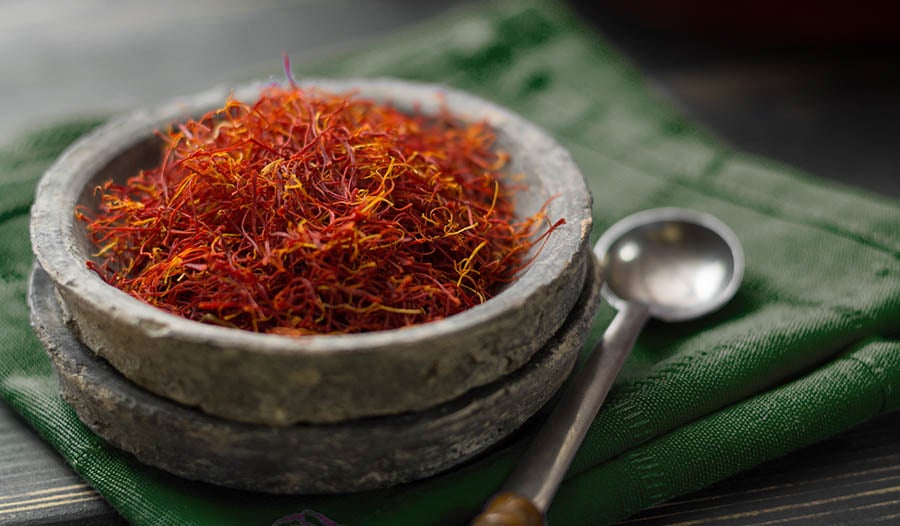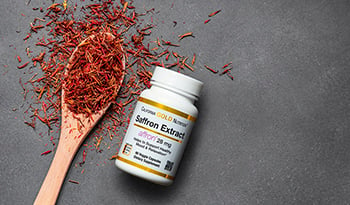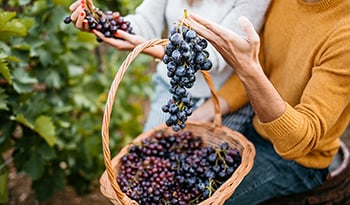藏红花:维护神经精神健康的天然方法
免责声明:本博客不提供诊断⋯

可以使用的主流疗法具有局限性,这使得有证据支持的补充性及替代性(CAM)疗法出现了。
效果有限、安全问题以及许多精神性药剂的高成本让更安全、更有效、价格更实惠的精神疾病疗法成为一个迫切的问题。经过数十年以及数十亿美元的工业资金投入后,支持广泛使用药剂缓解抑郁症、躁郁症、精神分裂症和其它精神疾病的证据不再令人信服了。这些问题导致越来越多有精神健康问题的人从补充性及替代性医学(CAM)实践者——包括中医实践者、自然疗法医生、草药师、按摩疗法医生、顺势疗法医生和其它实践者——那里寻求疗法。随着人们对综合精神健康护理的关注越来越高,藏红花作为一种针对各种神经精神疾病的有希望的方法出现了。
藏红花与多种神经精神疾病的疗法
藏红花(番红花)具有刺激性欲、祛痰、止痉挛、消毒和促进认知的作用,因而其在波斯医学和中医中有很长的使用历史。藏红花对情绪低落、阿尔兹海默症和注意力缺乏多动症(注意力不集中症)可能具有有益的效果,这种效果得到累积的人类研究结果的支持。动物研究结果显示,藏红花也可能对被诊断患有焦虑症、精神分裂症和强迫症(OCD)的人具有有益的效果。藏红花的生物活性组分可能可以增加多巴胺和去甲肾上腺素的再摄取遏制,并可能可以作为N-甲基D-天门冬氨酸(NMDA)受体拮抗体和GABA致效剂发挥作用。本篇短文的其余部分将简单回顾藏红花对情绪低落、阿尔兹海默症、注意力缺乏多动症(注意力不集中症)的效果的研究发现。
藏红花与情绪低落
藏红花的抗抑郁益处可能是由于它所具有的多种机制,包括它在激活血清素、防氧化、防炎性、神经内分泌和神经保护方面所起的作用。对6项针对藏红花对轻度至中度情绪低落的效果的安慰剂对照研究进行了一次系统回顾并得出结论,藏红花和抗忧郁剂的效力相当。2019年一项包括11项针对藏红花对轻度至中度情绪低落人士的效果的安慰剂对照研究(总样本数大于500)在内的荟萃分析得出结论,藏红花的效果明显优于安慰剂,并且与选择性血清素再吸收遏制剂类的抗抑郁药(氟西汀和西酞普兰)的效力相当。藏红花与安慰剂的不良效果的发生率没有区别,甚至在使用高剂量藏红花(每天达到1.5毫克)的研究中也是如此。荟萃分析中所包含的全部研究都在伊朗进行,藏红花在那里传统上被用来缓解情绪低落和各种病症。另外,许多患者患有并存病。这两个因素可能会让结论存在偏颇。需要由独立研究团体进行大型安慰剂对照试验,以确认这些发现并确定最佳剂量和疗程。新的发现显示,不管是作为单一疗法还是抗抑郁剂的辅助疗法,姜黄素(来自姜黄)都具有抗抑郁的效果。也有证据显示,姜黄素与藏红花的结合可能会产生协同的抗抑郁益处。在一项为期12周的双盲安慰剂对照研究中,与安慰剂对照组相比,随机使用低剂量姜黄素提取物(每天两次,每次250毫克)、高剂量姜黄素提取物(每天两次,每次500毫克)或结合使用低剂量的姜黄素与藏红花(每天两次,每次15毫克)的重度抑郁症患者在情绪方面得到显著的改善。需要进行更多研究来确定这些草本产品的不同剂量是否会产生不同的抗抑郁效果。
藏红花的培植和采摘是劳动密集型工作,需要花上数百个小时手工采摘数千朵花朵的柱头。其结果就是世界市场上优质藏红花的高成本和有限的供应量。为努力找到一种高产出、低成本来源的藏红花,研究者提取了藏红花球茎的数种活性组分,并研究了它们对老鼠情绪低落的行为模式的影响。研究者确认了两种生物活性组分,它们对抑郁症的效力可能可以与来自柱头的藏红花的效力相当。需要进行安慰剂对照试验,以确认该发现也适合患抑郁症的人士。
藏红花与注意力不集中症
包括哌醋甲酯在内的兴奋剂和其它被广泛使用缓解注意力不集中症的药剂会造成副作用,如失眠、食欲减退和腹痛。缓解成人注意力不集中症的兴奋剂和其它药剂疗法所取得的效果可能只是它们对于儿童的效果的一半。对于这些问题的广泛担忧已经引起人们对有希望的天然产品和其它补充性与替代性方式进行研究。
藏红花的生物活性组分可能可以增加多巴胺和去甲肾上腺素的再摄取遏制,并可能可以作为N-甲基D-天门冬氨酸(NMDA)受体拮抗体和GABA致效剂发挥作用。两种机制都被认为对注意力不集中症的症状具有有益的缓解效果。一项针对注意力不集中症儿童患者和青少年患者的为期6周的随机双盲研究发现显示,藏红花(每天20到30毫克)和哌醋甲酯(每天20到30毫克)的效力在家长和老师的症状评估量表中相当。这一发现应被视为由大型且为期时间长的安慰剂对照研究做出的初步确认。
藏红花与阿尔兹海默症
新的研究发现正在证实传统医学长期以来所宣称的观点,即藏红花可能可以改善健康人士的认知功能,并且可能可以减轻阿尔兹海默症患者的认知障碍症状。藏红花促进认知的效果被认为是由防氧化成分和抗击淀粉样蛋白的活性予以调节的。针对藏红花对阿尔兹海默症的效果的安慰剂对照研究结果一致报告了其对认知具有益处。在一项为期22周的安慰剂对照试验中,55位轻度至中度阿尔兹海默症患者随机使用藏红花(每天两次,每次15毫克)与多奈哌齐(医生广泛开具的一种胆碱酯酶遏制剂,每天两次,每次5毫克)。根据标准化症状评估量表,该试验显示,藏红花与多奈哌齐对于行为和认知功能的改善效果相当。阿尔兹海默症与情绪低落的高共病率让藏红花成为这些人群的合理选择。
藏红花、焦虑、精神分裂症与强迫症
除了其对情绪低落、阿尔兹海默症和注意力不集中症可能具有的有益效果,动物研究的新发现还显示,藏红花对焦虑症、精神病和强迫症的症状可能具有有益效果。但是,到目前为止,在人类临床试验中尚未研究藏红花对于这些疾病的效力。藏红花生物活性组分的抗焦虑、抗精神病和抗强迫的一种或多种机制尚未被阐明,但是可能与GABA-A和N-甲基D-天门冬氨酸神经递质系统有关。
藏红花、防氧化成分与神经保护作用
可以使用的精神健康问题传统疗法具有局限性,这刺激了对于各种补充性与替代性(CAM)疗法的研究。在其它非药剂疗法中,藏红花作为缓解神经精神疾病的一种疗法近年来越来越受到关注。研究结果显示,藏红花可能具有显著的防氧化和神经保护作用,并且可能是缓解轻度至中度情绪低落、轻度至中度阿尔兹海默症的一种安全而有效的疗法。一项最近的研究显示,藏红花在缓解注意力不集中症方面的效力与中枢神经兴奋剂的效力相当。预临床动物研究的初步结果显示,藏红花可能具有显著的抗焦虑、抗精神病、抗强迫的效力。需要进行大型且为期时间长的安慰剂对照研究,以确认以上发现、确定理想的剂量以及研究藏红花如何安全且适当地与其它天然产品和精神药剂结合使用。
参考文献:
- Akhondzadeh Basti A, Moshiri E, Noorbala A-A, Jamshidi A-H, Abbasi SH, Akhondzadeh S:Comparison of petal of Crocus sativus L. and fluoxetine in the treatment of depressed outpatients:A pilot double-blind randomized trial.Prog Neuropsychopharmacol Biol Psychiatry 31:439–442, 2007.
- Akhondzadeh S, Shafiee Sabet M, Harirchian MH, Togha M, Cheraghmakani H, Razeghi S, Hejazi SS, Yousefi MH, Alimardani R, Jamshidi AH, Zare F, Moradi A (2009) Saffron in the treatment of patients with mild to moderate Alzheimer’s disease: a 16-week, randomized and placebo controlled trial.J Clin Pharm Ther
- Akhondzadeh, S. et al, A22-week, multicenter, randomized, double-blind controlled trial of Crocus sativus in the treatment of mild-to-moderate Alzheimer’s disease, Psychopharmacology (2010) 207:637–643
- Barnes PM, Bloom B, Nahin RL.Complementary and alternative medicine use among adults and children:United States, 2007.Natl Health Stat Report 2008 Dec 10;(12):1-23.
- Baziar, S., Aqamolaei, A., Khadem, E., Mortazavi, S., Naderi, S. et al (2019) Crocus sativus L. Versus Methylphenidate in Treatment of Children with Attention-Deficit/Hyperactivity Disorder:A Randomized, Double-Blind Pilot Study.J Child Adolesc Psychopharmacol.29:3; 1-8.
- Berman SM, et al.Potential adverse effects of amphetamine treatment on brain and behavior: a review.Mol Psychiatry.2009;14(2):123–42.
- Denys, D., de Haan, L., (2008) [25 years antipsychotics: back to the future?][Article in Dutch] Tijdschr Psychiatr.2008;50 Spec no.:105-9.
- Fernandez JA (2004) Biology, biotechnology and biomedicine of saffron.Recent Res Dev Plant Sci 2:127–159.
- Fournier JC, DeRubeis RJ, Hollon SD, et al.Antidepressant drug effects and depression severity:A patient-level meta-analysis.JAMA 2010 Jan 6;303(1):47-53.
- Georgiadou G, Tarantilis PA, Pitsikas N. Effects of the active constituents of Crocus Sativus L., crocins, in an animal model of obsessive-compulsive disorder.Neurosci Lett.2012 Oct 18;528(1):27-30.
- Hartling L, Abu-Setta AM, Dursun S, Mousavi SS, Pasichnyk D, Newton AS.Antipsychotics in adults with schizophrenia:Comparative effectiveness of first-generation versus second-generation medications:A systematic review and meta-analysis.Ann Intern Med 2012 Oct 2;157(7):498-511.
- Herrmann N, Chau SA, Kircanski I, Lanctôt KL.(2011) Current and emerging drug treatment options for Alzheimer’s disease:A systematic review.Drugs 22;71(15):2031- 65.
- Kanchanatawan B, Tangwongchai S, Sughondhabhirom A, Suppapitiporn S, Hemrunrojn S, Carvalho AF, Maes M. Add-on Treatment with Curcumin Has Antidepressive Effects in Thai Patients with Major Depression:Results of a Randomized Double-Blind Placebo-Controlled Study.Neurotox Res.2018 Apr;33(3):621-633.
- Kelley J. (2 March 2010) Antidepressants:Do they “work” or don’t they?[Internet].New York, NY:Scientific American; 2010 Mar 2
- Kirsch I, Deacon BJ, Huedo-Medina TB, Scoboria A, Moore TJ, Johnson BT.(2008) Initial severity and antidepressant benefits:A meta-analysis of data submitted to the Food and Drug Administration.PLoS Med 5(2):e45.
- Lopresti AL, Drummond PD.Efficacy of curcumin, and a saffron/curcumin combination for the treatment of major depression:A randomised, double-blind, placebo-controlled study.J Affect Disord.2017 Jan 1;207:188-196.
- Lopresti AL, Drummond PD.Saffron (Crocus sativus) for depression: a systematic review of clinical studies and examination of underlying antidepressant mechanisms of action.Hum Psychopharmacol.2014 Nov;29(6):517-27.
- Lopresti AL, Maes M, Maker GL, Hood SD, Drummond PD.Curcumin for the treatment of major depression: a randomised, double-blind, placebo-controlled study.J Affect Disord.2014;167:368-75.
- Negbi M (1999) Saffron cultivation: past, present and future prospects.In:Negbi M (ed) Saffron Crocus sativus L. Harwood, Amsterdam, pp 1–17.
- Newcorn JH, et al.The complexity of ADHD: diagnosis and treatment of the adult patient with comorbidities.CNS Spectr.2007;12(8 Suppl 12):1–14.
- Papandreou MA, Kanakis CD, Polissiou MG, Efthimiopoulos S, Cordopatis P, Margarity M, Lamari FN (2006) Inhibitory activity on amyloid-beta aggregation and antioxidant properties of Crocus sativus stigmas extract and its crocin constituents.J Agric Food Chem 15:8762–8768
- Pitsikas N, Boultadakis A, Georgiadou G, Tarantilis PA, Sakellaridis N:Effects of the active constituents of Crocus sativus L., crocins, in an animal model of anxiety.Phytomedicine 15:1135–1139, 2008.
- Pitsikas N, Sakellaridis N:Crocus sativus L. extracts antagonize memory impairments in different behavioural tasks in the rat.Behav Brain Res 173:112–115, 2006.
- Pitsikas, N., Constituents of Saffron (Crocus sativus L.) as Potential Candidates for the Treatment of Anxiety Disorders and Schizophrenia Molecules.2016 Mar; 21(3):303.
- Rı´os JL, Recio MC, Giner RM, Ma´n˜ez S:An update review of saffron and its active constituents.Phytother Res 10:189–193, 1996.
- Schachter HM, et al.How efficacious and safe is short-acting methylphenidate for the treatment of attention-deficit disorder in children and adolescents?A meta-analysis.2001;165(11):1475–88.
- Schmidt M, Betti G, Hensel A (2007) Saffron in phytotherapy: pharmacology and clinical uses.Wien Med Wochenschr 157:315–319
- Srivastava R, Ahmed H, Dixit RK, Dharamveer, Saraf SA:Crocus sativus L.:A comprehensive review.Pharmacogn Rev 4:200–208, 2010.
- Stafford MR, Mayo-Wilson E, Loucas CE, et al.2015 Efficacy and safety of pharmacological and psychological interventions for the treatment of psychosis and schizophrenia in children, adolescents and young adults:A systematic review and meta-analysis.PloS One Feb 11;10(2):e0117166.
- Thase ME.STEP-BD and bipolar depression:What have we learned?Curr Psychiatry Rep 2007 Dec;9(6):497-503.
- Tóth B, Hegyi P, Lantos T, Szakács Z, Kerémi B, Varga G, Tenk J, Pétervári E, Balaskó M, Rumbus Z, Rakonczay Z, Bálint ER, Kiss T, Csupor D. The Efficacy of Saffron in the Treatment of Mild to Moderate Depression:A Meta-analysis.Planta Med.2019 Jan;85(1):24-31.
- Velligan DI, Weiden PJ, Sajatovic M, et al; Expert Consensus Panel on Adherence Problems in Serious and Persistent Mental Illness.The expert consensus guideline series:Adherence problems in patients with serious and persistent mental illness.J Clin Psychiatry 2009;70 Suppl 4:1-46.
- Wang et al (2010) Antidepressant properties of bioactive fractions from the extract of Crocus sativus L. J Nat Med (2010) 64:24–30.
- Wang Y, Han T, Zhu Y, Zheng CJ, Ming QL, Rahman K, Qin LP:Antidepressant properties of bioactive fractions from the extract of Crocus sativus L. J Nat Med 64:24–30, 2010.
- Xuabin N (1992) Research progresses on the saffron crocus (Crocus sativus).Zhongcaoyao 23:100–107.

 作者 詹姆斯·莱克博士(Dr. James Lake),医级博士
作者 詹姆斯·莱克博士(Dr. James Lake),医级博士


